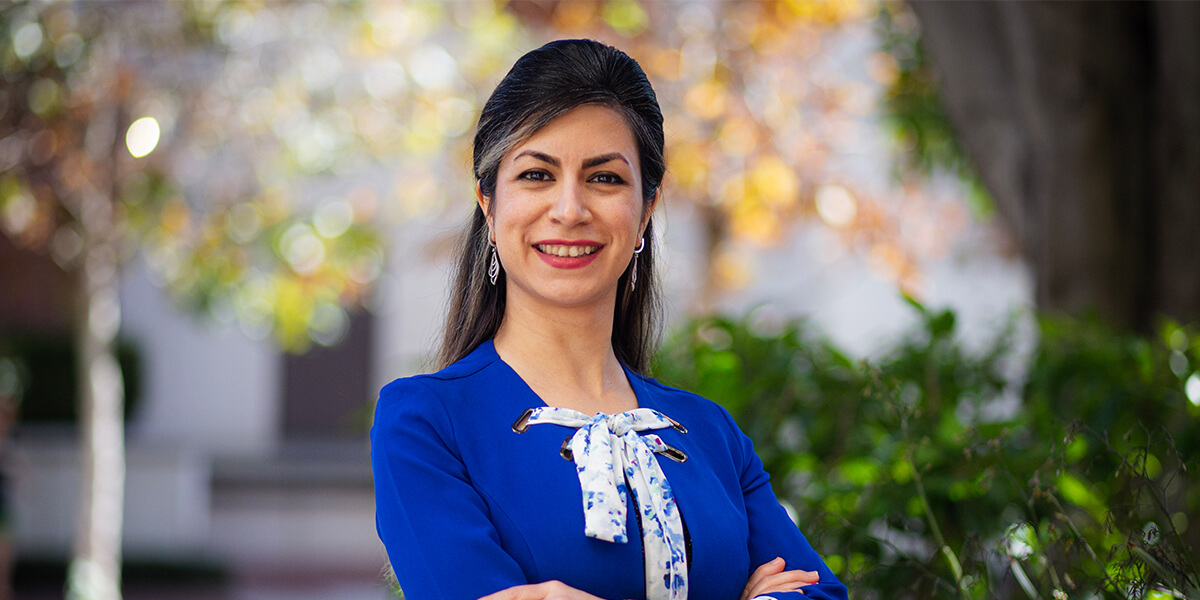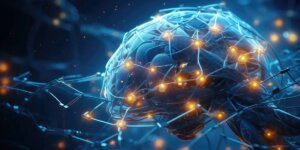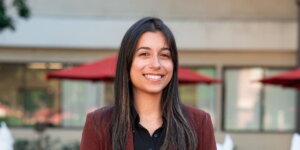
Neda Maghsoodi, Gabilan Assistant Professor in the Department of Aerospace and Mechanical Engineering
For Neda Maghsoodi, the impulse to empower others is at the core of her practice as a researcher, a teacher and a citizen of the world.
When she received the offer to take on the role of a Gabilan Assistant Professor in the Department of Aerospace and Mechanical Engineering at USC Viterbi School of Engineering, her attention was consumed by the women-led uprisings in Iran, her country of origin. Time Magazine honored the women of Iran as the heroes of the year in 2022, and Maghsoodi found herself reflecting upon the ways she could participate. ‘Woman, life, freedom.’ That slogan is not only for Iran – it’s for women all over the world.”
The inclusion of women and other underrepresented individuals within her field is a key priority as Maghsoodi builds her research group at USC. Consisting of graduate students, with the assistance of undergraduates, the group will study the dynamics of soft biological systems for the purpose of innovating new bioinspired devices.
Maghsoodi is also considering developing a series of workshops intended to build the confidence of women in engineering. “I think it’s really important to give women the support they need to express themselves, whether in an academic or an industry setting,” she said. “I want them to know that they are powerful.”
Thinking and teaching
Maghsoodi found her own source of empowerment in her determination to work in academia. After earning her master’s degree in mechanical engineering from Amirkabir University of Technology in Tehran, she went on to achieve a Ph.D. from the University of Michigan, Ann Arbor, followed by post-doctoral research at Harvard University’s Department of Molecular and Cellular Biology and the Department of Mechanical and Civil Engineering at California Institute of Technology (Caltech).
Her love of the deeply cerebral work of research translates naturally into a flair for teaching – the sense of fulfilment that arises from sharing her knowledge and enthusiasm with others. Since joining USC in January 2023, one of her first priorities has been getting to know the students and she is currently teaching an introductory course in dynamics for undergraduates.
“I had certain criteria that helped me identify where I wanted to work,” said Maghsoodi. “One consideration was the reputation of the university. Another was the facilities and equipment I would have access to, and the excellence of the faculty and students I would be interacting with. Then there was the factor of university culture – whether I felt supported by a healthy academic environment. It was clear that USC had all these qualities.”
From mathematics to medicine
Maghsoodi’s research is highly interdisciplinary, positioned at the interface of mechanical engineering, biology and materials science. “I study the dynamics of soft structures and materials, both biological and artificial,” she explained. “My area of research thrives on collaboration, and the attitude of my colleagues makes that possible. There’s a willingness to test new ideas, which is essential for interdisciplinary problem solving.”
The small-scale structures Maghsoodi studies – such as viruses and DNA – are difficult to fully engage in experiments, so she builds physics-based mathematical models and simulations to investigate how they work. “By modelling how these structures function and deform, we can apply those processes to the design of new devices which can be effective in fields such as medicine.”
One example is the structure of viruses. “We associate viruses with disease, but some viruses – such as bacteriophages – are our friends. They protect us from infections by injecting DNA into harmful bacteria”, said Maghsoodi. “The injection machinery of a bacteriophage has evolved over time so that the virus can be efficiently hosted in the body. If we can understand this process, we can make important advances in the development of drug delivery machinery.”
By studying the injection machinery of viruses, she produces bioinspired models that can be applied for the optimization of the targeted drug delivery. She’s also fascinated by photomechanical materials, active materials that are impacted by illumination. “The functioning and deformation of photomechanical materials can teach us about the remote activation of nanoscale robots, such as micro-swimmers that travel through fluids, or micro-mixers that can combine materials at the nanoscale.” Rather than developing the devices themselves, Maghsoodi’s research is all about investigating the capabilities of different soft materials, and ways of applying those capabilities to innovative designs in soft robotics.
Expression is empowerment
A significant portion of Maghsoodi’s work is theoretical, working in terms of abstract calculations. However, she is also a very visual thinker. As a teenager, Maghsoodi was trained in the ancient painting and drawing techniques of Iran – in fact, she once considered becoming a professional artist. “For me, painting is a space of transition that allows me to relax my mind and then return to the research,” she said.
Her work, which finds inspiration in natural forms, is primarily for herself – however, the empty walls of her new office have prompted a new way of thinking about her practice. “I’ve been considering using my painting abilities to visualize my research,” she said.
Maghsoodi’s work reveals a little-known secret about engineers. Those who are attentive to the inner structures and workings of the world are often uniquely attuned to the dynamics of human lives, both in terms of the personal and the political. “I want to train a new generation, and to share what I know,” said Maghsoodi. For students, that foundation of training and support provides a platform for seeking out new knowledge and ways of looking at the world – an attitude to life that could be described as freedom.
Published on March 27th, 2023
Last updated on March 27th, 2023













